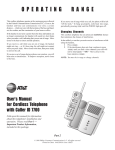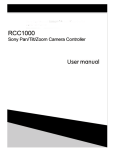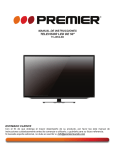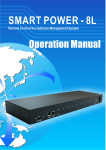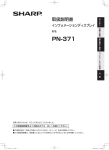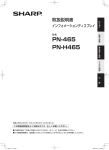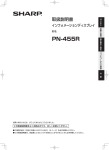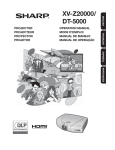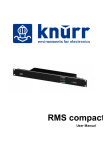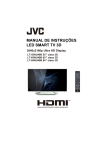Download KALED423DSMTZA User Manual
Transcript
.$/(''607=$
USER MANUAL
Important Safety Instructions and Maintenance
Important Safety Instructions
CAUTION
Risk of electronic shock, do not open.
Do not attempt to service this product yourself
as opening or removing covers may expose
you to dangerous voltage or other hazards.
Refer all servicing to qualified service personnel.
High Voltage
Do not open
If the following problems occur:
Turn off the TV set and unplug the AC power cord
immediately if any of the following problems occur.
Ask your dealer or service centre to have it checked
by qualified service personnel
When:
- AC power cord is damaged.
- Poor fitting of AC power outlet.
- TV set is damaged by being dropped, hit or having something thrown at it.
- Any liquid or solid object falls through openings in the cabinet.
To reduce the risk of fire or electric shock, do not
expose this product to rain or moisture.
The apparatus shall not be exposed to dripping
or splashing and no objects filled with liquids,
such as vases, shall be placed on the apparatus.
The screen and cabinet get warm when the TV
is in use. This is not a malfunction.In case of
smoke, strange noise or strange smell from the
unit:
· Turn off the power switch immediately;
· Disconnect the power plug from the power
outlet;
· Contact your dealer or service centre. Never attempt to make repairs
yourself because this could be dangerous.
Never push objects of any kind into the set
through the cabinet slots as they may touch
dangerous voltage points or short-circuit parts that
could result in a fire or electric shock. Never spill
liquid of any kind on the set. Use special caution
in households where children are present. The apparatus is not suitable for children
under 3-year to operate.
Do not overload wall outlets, extension cords or
adaptors beyond their capacity, this can result in
fire or electrical shock.
Power-supply cords should be routed so that they
are not likely to be walked on or pinched by items
placed upon or against them, paying particular attention to cords at plug end, adaptors
and the point where they exit from the appliance. The mains plug is used as the
disconnect device. It shall remain readily accessible and should not be obstructed
during intended use. Make sure to plug the power cord in until it is firmly inserted.
When removing the power cord, make sure to hold the power plug when pulling the
plug from the outlet, do not pull the plug out by the wire. NEVER touch the plug or
power cord with wet hands. To disconnect the apparatus from the mains power, the
plug must be pulled out from the mains socket, therefore make sure the mains plug
is always easily accessible.
1
Important Safety Instructions and Maintenance
Important Safety Instructions
Do not push or scratch the front filter, or place any objects on top of the TV set. The
image may be uneven or the screen may be damaged.
To avoid the fire, no naked flame source,
such as lighted candles, should be placed on the
apparatus.
An outside antenna system should not be located in
the vicinity of overhead power lines or other electric
light or power circuits, or where it can fall into such
power lines or circuits. When installing an outside
antenna system, extreme care should be taken to keep
from touching such power lines or circuits as contact
with them might be fatal.Ensuring the television is not
overhanging the edge of the supporting furniture.
When not in use
If you will not be using the TV set for several days, the
TV set should be disconnected from the AC mains for
environmental and safety reasons. As the TV set is not
disconnected from the AC power when the TV is turned
off at the standby switch, pull the plug from the AC power
outlet to disconnect the TV completely. However, some
TV sets may have features that require the TV set to be
left in standby to function correctly. In the case of lightning,
unplug the TV set from the outlet immediately. Never
touch the antenna wire during lightning.
Do not pull the plug out by the wire;
Never touch the plug with wet hands.
Excessive volume from earphones and headphones
can cause hearing loss.
Installation
The ventilation should not be impeded by covering the
ventilation opening with items, such as newspapers,
tablecloths, curtains, etc.
At least 10 cm space should be left around the
apparatus for sufficient ventilation.
The product should be situated away from heat
sources such as radiators, heat registers, stoves, or
other products (including amplifiers) that produce heat.
Place the apparatus in such a position that the screen
is not exposed to direct sunlight. It is best to have soft
indirect lighting while watching and avoid completely
dark environments and reflection from the screen as
these may cause eye fatigue.
Keep the TV set away from any equipment emitting
electromagnetic radiation.
2
Important Safety Instructions and Maintenance
Installation
Do not place the set on an unstable cart, stand, table
or shelf. The set may fall, causing serious personal
injury as well as damage to the product. Use only with
the cart, stand, tripod, bracket, or table specified by
the manufacturer, or sold with the apparatus. An
appliance and cart combination should be moved with
care. Quick stops, excessive force, and uneven
surfaces may cause the appliance and cart
combination to overturn.
Do not place this apparatus near water, for example,
near a bath tub, wash bowl, kitchen sink, or laundry
tub; in a wet basement; or a swimming pool; and
the like;
Move
When the TV being moved in from cold place, it needs
some right time for dew inside unit evaporating fully
before turn on the unit;
To prevent injury, this apparatus must be securely
attached to the floor/wall in accordance with the
installation instructions.
LED Screen
Although the LED screen is made with high precision technology and 99.99% or
more of the pixels are effective, black dots may appear or bright points of light (red,
blue or green) may appear constantly on the LED screen. This is a structural property
of the LED screen and is not a malfunction.
If the surface of the LED panel cracks, do not touch it until you have unplugged the
AC power cord. Otherwise electric shock may result.
Do not throw anything at the TV set. The LED panel may break from the impact and
cause serious injury.
Precautions When Displaying a Still Image
A still image may cause permanent damage to the TV screen.
Do not display still images and partially still images on the LED panel for more
than 2 hours as it can cause screen image retention. This image retention is
also known as "screen burn". To avoid such image retention, reduce the
degree of brightness and contrast of the screen when displaying a still image.
Watching the LED TV in 4:3 format for a long period of time may leave traces
of borders displayed on the left, right and centre of the screen caused by the
difference of light emission on the screen. Playing a DVD or a game console
may cause a similar effect to the screen. Damages caused by the above effect
are not covered by the Warranty.
Displaying still images from Video games and PC for longer than a certain
period of time may produce partial after-images. To prevent this effect, reduce
the 'brightness' and 'contrast' when displaying still images.
Cleaning
Cleaning and handling the screen
surface and cabinet. Disconnect
the unit from the AC outlet before
cleaning. To remove dust, wipe
gently with a soft, lint free cloth. If
required use a slightly damp cloth.
solvent thinner
MAINS PLUG
Wipe the mains plug with
a dry cloth at regular
intervals. Moisture and
dust may lead to fire or
electrical shock.
Use care not to subject the TV's surfaces to detergent.
(A liquid inside the TV could lead to product failure, fire or
electrical shock.)
Use care not to subject surfaces to bug repellent, solvent,
thinner, or other volatile substances as this may deteriorate the
surface and finish of the cabinet.
3
Important Information
Keep small accessories out of reach of children so they are not mistakenly swallowed.
Table of Contents
Accessories-----------------------------------------------------------------------------------------------5
Introduction-----------------------------------------------------------------------------------------------6
Features---------------------------------------------------------------------------------------------------------6
Specifications--------------------------------------------------------------------------------------------------7
Stand and wall-mounting instructions (optional)------------------------------------------------8
General Description--------------------------------------------------------------------------------10
Overview of back panel------------------------------------------------------------------------------------10
Overview of front panel-------------------------------------------------------------------------------------11
Overview of remote control-------------------------------------------------------------------------------12
Teletext --------------------------------------------------------------------------------------------------------14
Installing Batteries in the Remote Control------------------------------------------------------------16
External Connection------------------------------------------------------------------------------16
Antenna connection----------------------------------------------------------------------------------------16
Connecting VCR -------------------------------------------------------------------------------------------17
Connecting a Camcorder---------------------------------------------------------------------------------18
Connecting a DVD Player/Set-Top Box via DVI ----------------------------------------------------19
Connecting DVD Player/Set-Top Box via HDMI ----------------------------------------------------20
Connecting Digital Audio System-----------------------------------------------------------------------21
Connecting PC ---------------------------------------------------------------------------------------------22
Supporting signals ---------------------------------------------------------------------------------------22
Basic operation---------------------------------------------------------------------------------------23
Turning the TV on and off---------------------------------------------------------------------------------23
The main interface------------------------------------------------------------------------------------------24
Applications of the TV--------------------------------------------------------------------------------------25
Menu system instruction-----------------------------------------------------------------------26
TV menu-------------------------------------------------------------------------------------------------------26
Sound----------------------------------------------------------------------------------------------------------26
Image-----------------------------------------------------------------------------------------------------------28
Program-------------------------------------------------------------------------------------------------------29
Input Source--------------------------------------------------------------------------------------------------31
3D---------------------------------------------------------------------------------------------------------------31
Function-------------------------------------------------------------------------------------------------------32
Time------------------------------------------------------------------------------------------------------------34
PVR-------------------------------------------------------------------------------------------------------------35
Digital Media Player --------------------------------------------------------------------------------------38
Troubleshooting -------------------------------------------------------------------------------------------41
Picture defects and the reason------------------------------------------------------------------------43
4
Accessories
Please make sure the following items are included with your LED TV. If any items are
missing, contact your dealer.
HOME
Remote Control
Note: Detail operation please refer to HELP menu on the TV.
5
Introduction
Features
l
l
l
l
l
l
l
l
l
l
l
l
l
l
TV adopts 42” TFT LED display screen
Zero X radiation complies to green environment protection requirement
Connect to computer directly to realize TV/monitor combo.
MHL2.0
Android4.2
USB3.0
16:9 wide screen
Auto tuning and fine tuning
HDMI input
Component Compatible (480i; 480P; 576i; 576P; 720P; 1080i; 1080P)
PC VGA
Programmable sleep timer
Wide range voltage input
No-signal automatic power off
Input terminals used for external equipment connection
1 x ANTENNA jack
4 x HDMI inputs
1 x computer PC-RGB input
3 x USB inputs
1 x COMPONENT input
1 x CVBS output
1 x AV input
1 x SPDIF output
1 x Headphone output
6
Introduction
Specifications
Model
KALED423DSMTZA
Display size
42” Diagonal (max.)
LED panel resolution
1920X1080
Speaker output power
³ 5 W X2
Power supply
~110-240V, 50/60Hz
TV receive system
Digital: DVB-T
Analog: PAL: BG, I, DK,
SECAM: BG, D/K
Frequency range
Analog: Antenna:
46.25MHz-855.25MHz
Digital:5-12, 21-69
Video in
PAL / NTSC / SECAM
Power consumption
90W
Standby consumption
<1W
Antenna Input
75 ohms, unbalanced
Controller power
DC 3V
(Two AAA size batteries)
958X250X623mm
958X52X566mm
16Kg
14Kg
Work Temperature
0 oC-40 oC
Note:
- Design and specifications are subject to change without notice.
- Weight and Dimension shown are approximate.
- It is suggested to watch 3D program under the operation temperature above 10oC to
obtain the best 3D effect.
7
Stand and wall-mounting instructions (optional)
Wall mounting instructions (optional)
Your LED TV is able to accommodate wall mounting with the use of a wall mount bracket
(not supplied with LED TV, please contact your local hardware store) and the mounting
holes on the back of the unit. We recommend removing the TV stand prior to wall mounting
the TV. Please see previous page for instructions on removing the stand.
Mounting instruction:
Your LED TV is able to wall mounting with the use of a wall mounting bracket(not supplied with LED
TV), and the mounting holes on the back of the unit. After detaching the stand:
1.Find the four mounting holes where you want to mount according to wall mounting bracket ③
and drill these four mounting holes on the wall.
2.Drive Nylon sleeves ② into the mounting holes on the wall tightly.
3.Fasten wall mounting bracket ③ on the Nylon sleeves with self-tapping screws ④;
4.Fasten screws ⑤ into the two screw holes on the rear cabinet;
5.Tighten bolt ⑦ on the bottom of the rear cabinet with screws ⑨,then put rubber gaskets ⑧ on
the bolt ⑦;
6.Left the TV and hang it on the wall.
②.Nylon sleeve (4 piece)
③.Wall mounting bracket(1 piece)
⑤.Mounting Screw (2 piece) ⑥.Rear cabinet
⑦.Bolt
⑨.Screw (2 piece)
400mm
400mm
①.Wall
④.Self-tapping screw(4 piece)
⑧.Rubber gaskets (2 piece)
9
General Description
Overview of back panel
You can connect the TV with video devices such as DVD/VCD player, VCR and video camera
to enjoy the high quality picture.
SPDIF
SPDIF
L
COMPONENT/AV IN
R
Pr
Pb
HDMI4
HDMI3
HDMI2
HDMI1(MHL)
VGA
AUDIO
ANT
Y/V
Headphone
Microphone
MIC
Video output
VIDEO
PC
SD card
Blu-ray disc player
DVD player
Camcorder
PC (HDMI-output)
USB 3
USB 3
(USB 3.0)
DVD player
USB 2
USB 2
USB 1
USB 1
10
General Description
Overview of front panel
The buttons on the lower-left panel control your TV’s basic features, including the on-screen
menu. To use the more advanced features, you must use the remote control.
INPUT
MENU
PROG
VOL
1 Power Switch
Press this button to turn TV on or off.
2 Remote Control
Sensor
Power Indicator
Aim the remote control towards this spot on the TV.
Green: In power on mode.
Red: In standby mode.
3 INPUT
Toggles between all the available input sources.
4 MENU
Press to display an on-screen menu of your TV's features.
5 PROGr/s
Press to change programs.
6 VOLv/w
Press to increase or decrease the volume.
7
Standby button
Press
button to toggle between normal and standby mode.
11
General Description
Overview of Remote Control
HOME
1. INPUT: This button is used to switch among
different sources: DTV,ATV, AV,YPbPr,VGA, HDMI1,
HDMI2, HDMI3, HDMI4.
Select a source and press OK button to confirm.
2. POWER: Press this button to switch to standby
mode, and press it again to turn TV on.
3. Digital buttons(0~9): To select channel with
digital buttons.
4. INFO: This button is used to start the "Current
Service Banner" application that provides
information about the current service.
5. RECALL: Switch to the previous program.
6. FREEZE: Press this button to freeze the image.
7. MENU: Press this button to display main menu or
exit the menu. When you are in the submenu, you
can press it to return the main menu.
8. SLEEP: TV will be switched off automatically at
preset sleep time if you have set sleep timer. Use
your remote control to set the sleep timer.
Press SLEEP button on the remote control, then
press this button again to set sleep time: off, 10,
20,30, 60,90,120,180, 240 min. Press MENU
button to exit when you have set the sleep timer.
After you have set sleep timer, press SLEEP button
again, you will see the Remaining time.
Notes: The sleep timer you have set will be
cancelled when the TV turns off or if a power
failure occurs.
9. CH.LIST: Press it to show channel list on screen.
10. FAV: Press it to display favorite list.
11. Arrow buttons: Press these buttons to move
cursor up/down/left/right for menu.
12. OK/REC LIST: Press this button to display a list
of recorded programs. In main menu and submenu,
it is a validation button.
13. GUIDE: In DTV source, this button is used to
start the EPG application.
14. Exit: Exit the menu.
15. DTV: Switch to DTV mode.
16. 3D/2D: Press this button to display the “3D setting”.
Note:It is suggested to watch 3D program under
the operation temperature above 10 C to
obtain the best 3D effect.
12
General Description
Overview of Remote Control
HOME
17. HOME: Press this button to enter the main interface
directly.
18. ASPECT: Press this button to switch the screen
mode.
19. VOLr and VOLs: Press these buttons to
adjust TV volume.
20. PROGrand PROGs: Press these buttons to
change channel upward or downward.
In the teletext, these buttons are used to
display the next page and previous page.
21. MUTE: Press this button to shut off sound of the
TV, press again to restore TV sound.
22.
Button/Audio Lang: In ATV source, the button
is used to set NICAM sound system.
In DTV source, the button is used to set the audio
language.
23. Red/Green/Yellow/Blue Command: These four
buttons are used to request linked buttons with the
current menu/page.
24. Teletext buttons: Detail operation please refer to
"Teletext “ in the next page.
25. Digital media player control button: Including
play/pause, stop, previous file, next file, backward,
forward, these buttons are used to control in USB
mode.
26. SOUND: This button is used to select the sound
mode.
27. PICTURE: This button is used to adjust the picture
mode.
28. MIX (
): Teletext buttons for mix function. It is also
used for recording function when TV is on DTV mode.
13
General Description
Teletext
HOME
13
Teletext is an information system broadcast by certain
channels which be consulted like a newspaper.
It also offers to subtitles for viewers with hearing
problems or who are not familiar with the transmission
language.
You can press these buttons to operate the teletext:
Text
Press TEXT button to enter or exit teletext mode.
Hold
Press HOLD button to toggle Hold function on or
off. When Hold is switched on, the page acquisition
is stopped. When Hold is switched off, the page
acquisition is started.
Size
Press SIZE button one time to display the upper
half of the screen in double height, press the SIZE
button two times to display the lower half of the
screen in double height, press three times to
display the full screen in normal size.
Red/Green/Yellow/Blue Command
These four buttons are used for quick access to
different pages as numbered at the bottom of the
screen.
Index
Press INDEX button, then index page displays.
Reveal
Pressing this button will reveal any hidden data
(answers to quizzes for example).Press the REVEAL
button again to return to normal screen.
14
General Description
Teletext
HOME
13
13
Cancel
The CANCEL button will exit from any Teletext on
the display. Press CANCEL button again to exit
Teletext and return to live TV broadcast.
Subtitle
Turning the Teletext subtitles on or off.
Subtitles is a separate mode with only a few
buttons available. There will be no OSD visible
other than the Teletext Subtitles.
Subcode
Subcode mode gives the possibility to select
certain subcode pages of a Teletext page.
Entry of digits within the range 0...9 for current
subcode entry. If the digit completes the entry,
a page request is started.
Press PROGr/PROGs buttons to change the
subcode pages.
Time
This button is used to show the time of the
Teletext.
Digital buttons(0~9)
You can press them to enter the number of the
Page required.
PROGr/PROGs
You can press them to change page upward or
downward.
Mix
Press MIX button, the teletext page changes
transparent, TV content and teletext page
content will display at the same time.
Press MIX button again to exit MIX mode.
15
General Description
Installing Batteries in the Remote Control
Installing Batteries
1
Open the battery compartment
cover on the back side.
2
Insert two 1.5V AAA size batteries
in correct polarity. Don´t mix old or
used batteries with new ones.
Point the remote towards the remote
control sensor of the TV and use it
within 8 meters.
Put the used batteries into the recycling bin since they can negatively
affect the environment.
3
Closed the cover.
The batteries (battery pack or batteries installed) should not be exposed to
excessive heat such as sunshine, fire or the like.
External Connection
Antenna connection
Antenna input impedance of this unit is 75ohm. VHF/UHF 75ohm coaxial cable can be
connected to the antenna jack directly, if the antenna cable is 300ohm parallel flat feeder
cable, you need to use the 300ohm/75ohm converter to connect the antenna cable to the
antenna jack. For details Please refer to the following drawing.
Antennas with 75 W Round Leads
Antennas with 300 W flat twins Leads
Use a 75ohm - 300ohm converter
ANT IN
75ohm coaxial cable
300ohm coaxial cable
Antenna cable
Antenna feeder
16
External Connection
Connecting VCR
These instructions assume that you have already connected your TV to an antenna or a
cable TV system. Skip step 1 if you have not yet connected to an antenna or a cable
system.
VCR Rear Panel
AUDIO OUT
1
2
TV Rear Panel
Red
White
Red
Blue
VIDEO OUT
Green
ANT ANT OUT S-VIDEO
3
SPDIF
White
2
3
RF Cable (Not supplied)
YPbPr cable( Not supplied)
Audio Cable (Not supplied)
R
Red
HDMI3
HDMI2
HDMI1(MHL)
VGA
L
Red
AUDIO
ANT
Blue
Green
COMPONENT/AV IN
1
Pr
Pb
Y/V
Follow the instructions in Viewing a VCR or Camcorder
Tape to view your VCR tape.
Each VCR has a different back panel configuration.
When connecting a VCR, match the color of the connection
terminal to the cable.
1. Unplug the cable or antenna from the back of the TV.
2. Connect the cable or antenna to the ANT IN terminal on
the back of the VCR.
3. Connect an RF Cable between the ANT OUT terminal
on the VCR and the ANT IN terminal on the TV.
4. Connect a Component Cable between the COMPONENT
[Y, Pb, Pr] jacks on the DVD player and YPbPr jack
on the TV.
5. Connect Audio Cables between the AUDIO OUT jacks
on the VCR and the AUDIO L and AUDIO R jacks on
the TV.
MIC
VIDEO
USB 3
(USB 3.0)
USB 2
Note: 1. Whenever you connect an external device to your TV,
make sure that power on the unit is turned off.
2. When connecting an external device, match the color
of the connection terminal to the cable.
17
USB 1
External Connection
Connecting a Camcorder
The rear panel jacks on your TV make it easy to connect a camcorder to your TV. They
allow you to view the camcorder tapes without using a VCR.
Each Camcorder has a different back panel configuration.
When connecting a Camcorder or DVD, match the color of the connection terminal to
the cable.
1. Connect a Video Cable between the AV1 VIDEO jacks on the TV
and the VIDEO OUT jack on the camcorder.
2. Connect Audio Cables between the AUDIO L and AUDIO R jacks on
the TV and the AUDIO OUT jacks on the camcorder.
3. Connect a Video Cable between the component IN Y on the TV
and the VIDEO OUT jack on the DVD.
4. Connect Audio Cables between the component IN AUDIO L and
R jacks on the TV and the AUDIO OUT jack on the DVD.
White
2 Audio Cable (Not supplied)
White
SPDIF
L
Red
Camcorder
COMPONENT/AV IN
R
Red
Yellow
1 Video Cable (Not supplied)
Pr
Pb
Y/V
MIC
VIDEO
Note:
1. Whenever you connect an external device to your TV, make sure that
power on the unit is turned off.
2. When connecting an external device, match the color of the connection
terminal to the cable.
USB 3
(USB 3.0)
USB 2
USB 1
18
External Connection
Connecting a DVD Player/Set-Top Box via DVI
This connection can only be made if there is a DVI Output connector on the external device.
TV Rear Panel
DVD Player/
Set-Top Box
HDMI4
HDMI3
HDMI2
HDMI1(MHL)
VGA
AUDIO
ANT
White
Red
2 Audio Cable (Not supplied)
1 DVI to HDMI Cable (Not supplied)
Each DVD player/STB has a different back panel configuration.
When connecting a DVD player/STB, match the color of the connection terminal to the
cable.
1. Connect a DVI to HDMI Cable or DVI-HDMI Adapter between the HDMI 1, HDMI 2, HDMI 3
or HDMI 4 connector on the TV and the DVI connector on the DVD player/Set-Top Box.
2. Connect Audio Cables between the PC AUDIO IN jack on the TV and the AUDIO OUT
jacks on the DVD player/Set-Top Box.
Note:
1.Whenever you connect an external device to your TV, make sure that power on the unit is
turned off.
2.When connecting an external device, match the color of the connection terminal to the
cable.
19
External Connection
Connecting DVD Player/Set-Top Box via HDMI
This connection can only be made if there is a HDMI Output connector on the external
device.
DVD Player/
Set-Top Box
TV Rear Panel
HDMI4
HDMI3
HDMI2
HDMI1(MHL)
VGA
AUDIO
ANT
HDMI Cable (Not supplied)
What is HDMI?
HDMI, or high-definition multimedia interface, is a next-generation interface that enables
the transmission of digital audio and video signals using a single cable without
compression.
Multimedia interface is a more accurate name for it especially because it allows multiple
channels of digital audio (5.1 channels).
The difference between HDMI and DVI is that the HDMI device is smaller in size, has the
HDCP(High Bandwidth Digital Copy Protection) coding feature installed, and supports
multi-channel digital audio.
Each DVD player/STB has a different back panel configuration.
1. Connect an HDMI Cable between the HDMI1, HDMI2, HDMI3 or HDMI4 connector on
the TV and the HDMI connector on the DVD player/Set-Top Box.
Note:
1.Whenever you connect an external device to your TV, make sure that power on the unit is
turned off.
2.When connecting an external device, match the color of the connection terminal to the
cable.
20
External Connection
Connecting Digital Audio System
The rear panel jacks on your TV make it easy to connect a Digital Audio System to your TV.
TV Rear Panel
Digital Audio System
(Black)
SPDIF
L
COMPONENT/AV IN
R
Pr
Pb
Y/V
Coaxial Cable (Not supplied)
MIC
VIDEO
USB 3
(USB 3.0)
USB 2
USB 1
5.1 CH audio is possible when the TV is connected to an external device supporting 5.1 CH.
1. Connect an Coaxial Cable between the SPDIF jacks on the TV and the Digital Audio Input
jacks on the Digital Audio System. When a Digital Audio System is connected to the
SPDIF terminal: Decrease the gain (volume) of the TV, and adjust the volume level with
the Digital Audio System's volume control.
21
External Connection
Connecting PC
HDMI4
HDMI3
HDMI2
HDMI1(MHL)
VGA
AUDIO
ANT
PC
2 PC Audio Cable (Not supplied)
1 D-Sub Cable (Not supplied)
Each PC has a different back panel configuration.
The HDMI jacks support PC connection.
1. Connect a D-Sub Cable between VGA/PC IN connector on the TV and the PC output
connector on your computer.
2. Connect a PC Audio Cable between PC AUDIO IN jack on the TV and the Audio Out jack
of the soundcard on your computer.
You should set PC software before you connect a PC to your TV (please refer to "PC
Display'' settings)
Note:
1. Whenever you connect an external device to your TV, make sure that power on the unit is
turned off.
2. When connecting an external device, match the color of the connection terminal to the
cable.
Supporting signals
Input
Mode
Input
DVB-T
DTV
PAL BG I DK
ATV
SECAM BG DK
CVBS
PAL/NTSC/SECAM
Input
Resolution
PC/VGA
640x480
800X600
1024X768
1280X1024
SXGA
1360X768
VGA
SVGA
XGA
Vertical
Frequency
60Hz
60Hz
60Hz
60Hz
60Hz
22
Resolution
480i
480p
576i
Component
576p
720p
1080i
1080p
480p
576p
720p
HDMI
1080i
1080p
640x480
800X600
DVI-HDMI
1024X768
1280X1024
Vertical
Frequency
60Hz
60Hz
50Hz
50Hz
50Hz/60Hz
50Hz/60Hz
50Hz/60Hz
60Hz
50Hz
50Hz/60Hz
50Hz/60Hz
50Hz/60Hz
60Hz
60Hz
60Hz
60Hz
Basic Operation
Turning the TV On and Off
1
How to turn the TV on or off
1. Insert the power cord plug into a polarized AC outlet.
2. If TV is in standby mode, press POWER button on
the remote control or button on the bottom panel
of LED TV.
3. Normal picture will be displayed on the screen after 15 seconds. If no signal input,
"No Signal" will be displayed on the screen.
4. If temporary POWER off is required, press POWER button on the remote control or
button on the bottom panel.
5. If you want to completely switch off the power for this unit, unplug the power cord plug
for this unit.
6. After switching off the unit, you should wait at least 5 seconds before switching on again.
Status indication lamp
Red: In standby mode.
Green: In power on mode.
Auto power-off
1. If there is no signal, the TV will automatically enter standby mode after 10 minutes.
2. In VGA mode, if no any operation 15 seconds later, TV will enter standby mode.
Memory before turning TV off
The picture and sound settings and preset channels will be memorised at the point when
the TV is turned off. When the TV is started up again it will work accordingly with these
settings.
23
Basic Operation
Menu operation
The main interface
You will enter the main menu directly after the TV is turned on.
Arrow buttons: Select menu and the selected menu's background will be orange.
OK button: Enter the options which you've selected.
INPUT button: You will enter the relevant function options directly.
Those state icons from left to right function as the following in turn:
1.Add to home screen
2. All apps
3. Change wallpaper
4. Search
5. Setting
6. Mass storage
7. Wired
Note:
1. The first area as the photo shown will display the current video images, and it will
display snowflake when there is no signal.
2. The second area shows some small desktop plug-ins, select one and press the OK
button, you will enter the relevant application program.
3. The third area is the entrance of the shortcut menu, select one and press the OK
button, you will enter the relevant shortcut options.
24
Basic Operation
Menu operation
Applications of the TV
Application menu shows all those applications which are together with the TV and those which
you've downloaded.
Menu Button: Open or Close the app's menu
Exit Button: Return to the main menu
Arrow Button: Select the application which you want
OK Button: Enter the application you've selected.
Note:
When the applications are of more than one page, and the focus is on left or right side of each
line, the left/right buttons can page up/down.
25
Menu system instruction
TV Menu
3 D
Sound
Image
Program
Input Source
3D
Function
Time
Menu button: Open the TV menu.
Exit button: Close the TV menu.
Arrow buttons: Select the application which you want.
OK button: Enter the selected application settings menu.
Note: Enter the function option by click the status bar.
Sound
Sound Mode
Sound Mode
Standard
Standard
Balance
Balance
...
...
0
0
Auto Volume
Auto Volume
Off
Off
Equalizer
Equalizer
Surround
Surround
Off
Off
SPDIF Mode
SPDIF Mode
RAW
RAW
HDMI Sound
HDMI Sound
HDMI
HDMI
3 D
3 D
Sound Mode
You can select the type of special sound settings to be used when watching a given
broadcast. Your TV has five sound settings (“Standard”,“Music”, “Movie”,“Sports”, “User”)
that are preset at the factory.
1. Press p/q key to select "Sound Mode" option.
2. Press t/u key to select one sound mode.
l Standard: Selects the normal sound mode.
l Music: Select the sound mode for music.
l Movie: Provides live and full sound for movies.
l Sports: Emphasizes bass over other sounds.
l User: Selects your custom sound settings (See "User settings for Sound”).
26
Menu system instruction
Sound
Equalizer
1. Press ▲/▼ key to select an equalizer item.
2. Press OK key to enter the equalizer submenu.
The sound settings can be adjusted to suit your
user preferences.
1. Press ▲/▼ key to select a particular item.
2. Press t/u key to decrease or increase the
value of a particular item.
Note: The adjusted values are stored according
to the selected particular item.
Equalizer
120Hz
30
500Hz
57
1.5KHz
57
5KHz
50
10KHz
50
Balance
If the volumes of the left speaker and the right speaker are not the same, you can adjust the
"Balance" to suit your personal preference.
1. Press p/q key to select "Balance" option.
2. Press t/u key to decrease or increase the value of the item.
Auto Volume
Each broadcasting station has its own signal conditions, and it is inconvenient to adjust
the volume every time the channel is changed. “Auto Volume” automatically adjusts the
volume of the desired channel by lowering the sound output when the modulation signal
is high or by raising the sound output when the modulation signal is low.
1. Press p/q key to select “Auto Volume" option.
2. Press t/u key to select “On” or “Off”.
Surround Sound
This is used to turn on surround sound to gain better sound effect.
1. Press p/q key to select "Surround sound" option.
2. Press t/u key to select “On” or “Off”.
SPDIF Mode
This is used to select "SPDIF Mode" .This option is only used in HDMI\DTV mode.
1. Press p/q key to select "SPDIF Mode" option.
2. Press t/u key to select "RAW" or "PCM".
HDMI Sound
This option is only used in HDMI mode.
1. Press p/q key to select “HDMI Sound" option.
2. Press t/u key to select HDMI Sound mode, HDMI or VGA.
27
Menu system instruction
Image
Picture Mode
Dynamic
Aspect Ratio
16:9
Color Temp
Cool
Backlight
100
Window Adjust
...
3 D
Picture Mode
Your TV has five picture settings (Standard, Soft, Vivid, User, Dynamic) that are preset at
the factory. Only "User" mode can be set to your preference by adjusting particular items
such as Contrast, Brightness,Color,Sharpness,Tint.
1. Press p/q key to select "Picture Mode" option.
2. Press t/u key to select one picture mode.
Aspect Ratio
You can select the picture size which best corresponds to your viewing requirement.
1. Press p/q key to select “Aspect Ratio" option.
2. Press t/u key to set the scale mode.
You can also press “Aspect” key on the remote control to select one of the scale modes.
Each source has different scale modes. (16:9, 4:3, Panorama, Movie, Subtitle, Dotbydot)
Color Temp
You can change the color of the entire screen
according to your preference.
1. Press p/q key to select "Color Temp" option.
2. Press t/u key to select one color temp.
Standard: Keeps whites white.
Warm: Makes whites reddish.
Cool: Makes whites bluish.
Adjusting the Backlight
You can change the brightness of the entire screen according to your preference.
1. Press p/q key to select "Backlight" option.
2. Presst/u key to select one backlight mode.
Backlight: Adjusts the brightness of the whole screen.
Window Adjust
Window Adjust
This option is only used when VGA mode has signal.
1. Press p/q key to select “Window Adjust” option.
2. Press OK key to display the “Window Adjust” menu.
Auto Adjust: Allows you to set the TV to self-adjust to
the incoming PC video signal. The fine, coarse and
position values are adjusted automatically
H-Position: Set horizontal position of picture.
V-Position: Set vertical position of picture.
Clock/Phase: Remove or reduce picture noise.
28
Auto Adjust
...
H-Position
50
V-Position
50
Clock
0
Phase
0
Menu system instruction
Program
Auto Search
...
EPG
...
ATV Manual Search
...
DTV Manual Search
...
Program Edit
...
Signal Information
...
3 D
Auto Search
Search Type
Press p/q key to select "Auto Search" option. Then
press OK key to start a notice window. In this notice
window, you can select country in the “Country
Selection” option and set “Tune Type” option.
The number of searched channels will be shown on
the screen.If you set “Tune Type” to “DTV+ATV”,
When the searching of DTV channels is over, TV will
start to search ATV channels. When the whole
searching is finished, all the channels will be stored
in memory, and a message will appear on the screen
as per the diagram on the right:
NOTE: If you want to exit the whole searching, you can
press EXIT button.
ATV/DTV
Australia
Bulgaria
Denmark
Austria
Croatia
Finland
Beligum
Czech
France
1/7
Auto Search
TV:
0 Programmes
DTV:
0 Programmes
RADIO:
0 Programmes
DATA:
1%
EXIT
0 Programmes
VHF CH 5A DTV
Exit
MENU
Skip
EPG(Used only in DTV)
1. Press p/q key to select “EPG" option.
2. Press “OK” key to enter EPG submenu.
Note: The details operartion please see the page37.
ATV Manual Search
In the ATV/DTV source, you can choose “ATV Manual Search” to enter “ATV Manual
Search” menu.
è Current CH:You can see the current channel number and you can press/ button to choose the channel you want to modify.
è Color System: Select the “Color System” option, press / on the remote control or TV. The color system will be changed
repeatedly in the order.PAL " SECAM
è Sound System: Select the “Sound System” option, press / on the remote control or TV.
The sound system will be changed repeatedly in the below order. BG " DK " I " L
è Search: you can use button to search channels from low frequency to high frequency and use button to search channels
from high frequency to low frequency. When you have searched a channel, the searching will be paused and you can press it
again for other channels after you store the channel.
è Fine Tune: In case of unfavorable image or sound of TV program, you can use “Fine Tune”.
è Skip: Select “Skip” option, “be changed” on the remote control or TV to switch, select “ON” to skip current program, select “OFF”
to add the program into the program list.
è Frequency: You can see the frequency of the searched channels.
29
Menu system instruction
Program
DTV Manual Search
In the ATV/DTV source, you can choose “DTV Manual
Search” to enter “DTV Manual Search” menu.
You can use /button to choose the channel and
press OK button to search, and then the TV will store
the DTV channel if there is a DTV signal present.
DTV Manual Search
CH37
Search
Signal Strength
Signal Quality
Program Edit
DTV:
You can use / button to choose “Program Edit” and
enter the menu, press the Blue/Red/Yellow color button on
the remote control to skip, delete and move programs, also
you can press FAV button to add to your favorite list.
è Delete:You can press RED button to enter "DEL" menu, then choose the
channel you want to delete and press RED button again to delete.
è Move:You can press / button to choose the channel in ATV mode you
want to move and press YELLOW button to move it.
è Skip:You can press / button to choose the channel you want to skip and
press BLUE button to skip it when you change channels.
è FAV:If you like the program of a channel, you can choose “FAV” button in the
menu to add it to your favorite list and later you can press “FAV” button in
the remote control to choose your favorite programs as soon as possible.
Signal Information(Used only in DTV)
1. Press p/q key to select “Signal Information" option.
2. Press “Ok”or u key ,you can see the information
of the DTV channel.
NOTE: Signal Quality/Signal Strength (DTV Only):
Unlike analogue channels, which can vary in reception
quality, digital channels must have perfect reception
quality or you will not receive them at all. So, unlike
analogue channels, you are not able fine tune a digital
channel. If the signal strength indicates that the signal
is weak, a possible solution is to adjust your antenna
to increase the signal strength. Continue to adjust the
antenna until you find the best position with the
strongest signal.
30
0
DATA:
0 RADIO:
OK
MENU
0
Return
Program Edit
9
Nine Digital
DTV
90
Nine Digital HD
DTV
99
Nine Guide
DTV
1
C-01
ATV
2
C-04
ATV
3
S-43
ATV
4
S-45
ATV
5
S-02
ATV
6
S-04
ATV
7
S-05
ATV
Skip
Delete
FAV
Signal Information
Channel
37
NetWork
Nine Melbourne
Modulation
64 QAM
Signal Strength
84%
Signal Quality
100%
Menu system instruction
Input Source
There are two ways to select input source.
1.Input Setup
Press INPUT key on the remote control to enter "INPUT SOURCE" menu. These options
for you to select: DTV, ATV, AV, YPbPr, VGA, HDMI1, HDMI2, HDMI3, HDMI4 . Use t/u
key to move the cursor to the input you desired and press OK key to confirm.
Figure1
DTV
ATV
AV
YPbPr
VGA
HDMI1
HDMI2
HDMI3
HDMI4
2. Input Source menu
DTV
ATV
AV
YPbPr
VGA
HDMI1
HDMI2
HDMI3
Figure2
HDMI4
3 D
1. Press MENU key to display the main menu on the screen.
2. Press t/u key to select "Input Source” option.
3. Press OK key to enter submenu.
3D
3D Left Right
3D Up Down
3D-Off
3D-2D
3D Clarity
3D Auto
3D Engine
Off
...
3 D
1. 2D-3D: Turn source film from 2D into 3D mode.
2. 3D-2D: Turn source film from 3D into 2D mode.
3. 3D-Off: Close 3D mode and set 2D mode.
31
Menu system instruction
3D
4. 3D Auto: When it is ON, all 3D source films will automatically switch to 3D mode. When it is
OFF, only the source film with 3D format sigh will automatically switch to 3D mode.
5. Left Right/Up Down/ 3D Clarity: set source films into different mode on the basis of different 3D
format.
6. 3D Engine:Press OK button to enter the "3D Engine" menu,you can set the 3D Effect and 3D
Sequence.
Note:
1. Watching 3D content for a long time may cause headache or eyestrain to you, please stop
watching if you have any uncomfortable feeling and take a rest immediately. Please consult a
doctor if the feeling do not released.
2. The appropriate 3D film sources are needed for watching 3D content.
3. It is suggested to watch 3D program under the operation temperature above 10°
c to obtain
the best 3D effect.
4. When in 3D mode, “2D-3D” can’t be selected. When in 2D mode, “3D-2D” can’t be selected.
Function
OSD Setting
...
Lock
...
PVR File System
...
Screen Saver
Off
Noise Reduction
Default
RGB Range
16~235
Reset
...
3 D
OSD Setting
You can modify the OSD set to suit your user
preferences.
1. Press p/q key to select “OSD Setting" option.
2. Press OK key to display the OSD setting menu.
OSD Language: select the proper language
OSD Time : Set the preferred amount of time for
the OSD to be displayed on the screen.
OSD Setting
OSD Language
English
OSD Timet
Always
Please enter password
Lock (Optional)
The lock feature requires a Password to be entered
before any settings can be changed.
1. Press p/q key and select "Lock" under the
"Function" menu.
2. Press OK key to enter "Lock" submenu, "Please
32
Cancel
Menu system instruction
Function
enter password" menu will appear, enter your 4-digit
password to enter "Lock" submenu (the default
password is 0000, and the ultimate overiding password
is 1980).
Lock System
1. Press p/q key to select "Lock System" option.
2. Press t/u key to select "On" or "Off".
Lock
Lock System
On
Set Password
...
Block Program
...
Parental Guidance
Off
Set Password
Please enter old password
Set Password
1. Press p/q key to select "Set Password" option.
2. Enter your 4-digit password to set the old password.
Choose any 4-digits for your new password and enter
them. As soon as the 4 digits are entered, the cursor
ill skip to “Confirm password” item, re-enter the same
4 digits, and your new password has been memorized.
Block Program
1. Press p/q key to select “Block Program” option.
2. Press OK key to enter Program Lock. In the program
list, use Blue key to lock or unlock the program. Once
the program is locked and Lock System is on, password
is needed to enter it.
Parental Guidance
This option only used in DTV mode.
1. Press p/q key to select “Parental Guidance” option.
2. Press t/u key to select the lock level of the Parental
Guidance: Off, 3, 4, 5, ..., 18.
Please enter new password
Confirm password
Program Lock
1
C-01
ATV
2
C-04
ATV
3
S-43
ATV
4
S-45
ATV
5
S-02
ATV
6
C-06
ATV
7
C-07
ATV
8
C-08
ATV
9
C-09
ATV
10
C-12
ATV
PVR File System
1. Press MENU key to display the main menu on the
screen.
2. Press p/q key to select “PVR File System” option.
3. Press OK key to enter “PVR File System" submenu,
for detailed operation refer to “PVR File System”.
PVR File System
Sekect Disk
Time Shift Size
Format Start
Speed Check
33
Menu system instruction
Function
Screen Saver
This option is only used in ATV mode.
1.Press p/q key to select “Screen Save” option.
2.Press t/u to choose on or off.
Noise Reduction
1. Pressp/qkey to select "Noise Reduction" option.
2. Presst/u key to select "Off", "Low", "Middle", "High" and "DEFAULT” to improve the
picture sharpness.
Note: Noise Reduction doesn't work in VGA Mode.
RGB Range
Change the brightness and saturation for a better picture.
1.Pressp/qkey to select "RGB Range" option.
2.Press t/u key to select "16~235" or "0~255".
Note: only available in HDMI mode, please select the appropriate setting according to the
DVD Player/STB.
RESET
Select the “Reset” option and press OK key to display a confirm box,and select “Yes” or “No”.
Note: Please use the "Reset" option with caution as it will return all settings and channel
memories to factory default
Time
2013/01/18 13:00
On Time
Off
Off Time
Off
Sleep Timer
Off
Time Zone
GMT+8:00
Clock Setting
Clock Setting
Auto Mode
In the first item, press OK button to enter the "Clock Setting"
menu to set the Date and Time.
In the "Auto Mode" item,you can get the time from DTV
or Net.
On Time
In "On Time” item, press OK button to enter the submenu,
set the time to turn on the TV set, when the TV set is in
the standby mode.
34
Off
Date
2013-04-18
Time
09:16
On Time
Switch
On
Time
12:00
Source
DTV
Menu system instruction
Time
Off Time
Off Time
In "Off Time" item, press OK button to enter the submenu,
set the time to turn off the TV set.
Switch
On
Time
00:00
Sleep Timer
1. Press p/q key to select "Sleep Timer" option.
2. Press t/u key repeatedly until the desired time
appears (Off, 10min, 20min, 30min, 60min, 90min, 120min, 180min, 240min).
Notes:
1.The sleep timer you have set will be cancelled when the TV turns off or if a power failure occurs.
2.When the time is less than 60 seconds, remind information will be displayed on the screen.
Press any key button to cancel timer function.
Time Zone
You can choose it to modify your time zone in the TV set.
1. Press p/q key to select "Time Zone" option.
2. Press t/u key to select time zone.
PVR
PVR File System
WARNING:
1. Before connecting your USB device to the TV, please back up your files to prevent them
from damage or loss of data.
2. A USB disk must be formatted when first used for PVR. Any existing data on the disk will
be lost during the formatting process. Please back up your disk if you do not want to lose
this data. You are recommended to use a dedicated disk for PVR use only. Do not
disconnect disk or power during formatting.
3. Do not modify PVR files on a PC.
Note: Make sure your USB device is compatible with the TV and able to support
PVR recording.
Select Disk
512M
1G
C: FAT
D: FAT
null
null
2G
Cancel
4G
35
Menu system instruction
PVR
Select Disk: Press “OK” button to enter submenu and press “t/u” to choose the disk for PVR.
Time Shift Size: Press “OK” button to enter submenu and press “p/q” to choose the size.
Format: Press “OK” button to enter format submenu. The disk must be formatted when first used
for PVR. Do not disconnect disk or turn power off during formatting.
When formatting your disk, a progress bar will appear on the display. NOTE: The larger
your device the longer it will take to format. The device may take many minutes to
format, this is not a malfunction, please wait for the formatting to finish.
Speed Check: Test your disk speed.
PVR Guide
If the disk for PVR is ready, the programs can be
recorded in DTV mode.
Time shift
In DTV mode, press “ / ” button to pause the DTV
program, press it again to continue play. The length of
time a program can be paused depends upon the
setting in the PVR File System.Press “EXIT” to stop
the time shift.
Press the PLAY button to continue playing the program
from the point where it was paused.
NOTE: Time Shift will stop if you change channels,
change inputs or go into standby mode while in Time
Shift mode.
CH9 Nine Digital
OK
HOME
MALCOLM IN THE MIDDLE
00:00:00
00:00:00
89%
Play
Stop
Pause
Rev
FF
SlowMotion TimePlay
C:FAT
Instant recording
1. Select the desired channel then press the “ ” button
on the remote control to start recording the current
broadcast, a progress bar will be displayed at the
bottom of the screen.
2. Recording stops when you press the EXIT button and
the recorded file is stored in the external USB device
automatically.
Play/Pause
Stop
Record
Forward
Back
NOTE: You can only watch channels on the same frequency as the program being recorded.
If you try to change to another channel or come to the main interface a message will appear
prompting you to continue or not “STOP RECORDING. System will stop record if user want to
channel up/down, Confirm or Cancel.”
Recording in standby mode
This unit is able to record while in standby mode.
Note: Start a recording then press the power button. A message will be displayed prompting you
to standby, stop or cancel.
36
Menu system instruction
PVR
DTV EPG (Electronic Program Guide)
In DTV mode, press “GUIDE” button to enter the Electronic Program Disabled.
At Guide menu, press "RED” button to "Record" Setting.
2007-01-18 16:01
EPG
Thursday
DTV
Friday
9 Nine Digital
90 Nine Digital HD
16:00 THE SHAK
Record Setting
Channel CH 90 Nine Digital HD
Start Time
Minute
0
Hour
16
Month
1
Date
18
Minute End Time 30
Hour
16
Month
1
Date
18
Mode
Once
99 Nine Guide
OK
Schedule
Saturday Sunday Monday Tuesday Wednesday
Ok
EXIT
Switch Day
Record
OK
Back
Reminder
INFO
INFO
V1.0.12 Build 7587
OK
At Guide menu, press "OK" button to "Reminder Settings".
Note: Press t/ubutton to adjust the scheduled time, press
OK button to save the setting.
2007-01-18 15:53
EPG
Thursday
DTV
Friday
9 Nine Digital
90 Nine Digital HD
Saturday Sunday Monday Tuesday Wednesday
Guide
HOME
16:00 THE SHAK
Reminder Settings
99 Nine Guide
Channel 90 Nine Digital HD
Minute
0
Hour
16
Month
1
Date
18
Mode
Once
OK
Schedule
Ok
Switch Day
Record
EXIT
OK
Red
Blue
Back
Reminder
INFO
INFO
V1.0.12 Build 7587
Press BLUE button to Schedule interface.
2007-01-18 16:01
Schedule
Channel ID
Channel Name
Event Name
90
CH90 Nine Digital HD
Once
2007-01-18 16:30 NATIONAL NINE AFTERNOON...
99
Ch99 Nine Guide
Once
2007-01-18 17:00 THE SHAK
OK
Delete
Return
37
Digital Media Player
Introduction
This TV is embedded with one USB port digital media player. It can find devices that support
USB1.1/2.0/3.0, including flash disk, USB hard disk and digital camera. It supports functions
as: Display pictures, Play music files, Play video files.
Note: please do not remove the cable during the data transfer. It may cause problems for
the system.
Data
Format
Picture
JPG,JPE,PNG,BMP
MP3, AAC
Music
MPG,MPEG,MP4,MOV,
Video
Device and File Management
Initialization Interface
On the main interface (page.24), click the “Mass storage”state icon to enter the USB
chanel. If no inserted U disk, the system will be prompted to insert the USB device, while
the screen displays "Storage DeviceRemove” message, the interface shown in Figure 1.
Disk Choice
Current Version: 1.2.00 Bulid:16114
Storage DeviceRemove
At present there is no storage equipment can be used, will soon
quit this module.
Quit
Figure 1
When you insert a USB disk, the interface shown in Figure 2.
OK key: to enter the selected letter.
Disk Choice
Current Version: 1.2.00 Bulid:16114
C:
Figure 2
38
Digital Media Player
USB support character
1. Photo
Press menu button to play/exit the "photo menu". Those menu items from left to right
function as the following in turn:
a.Wallpaper b.List c.Prev d.Play/Pause e.Next f.Stop g.Sequence h.Anticlockwise
i.Clockwise j.Zoom in k.Zoom out l.DragMode
002.jpg
Wallpaper
DragMode
Zoom out
Zoom in
Clockwise
Play
List
Prev
Play/Pause
Next
Anticlockwise
Sequence
Stop
2. Music
Those menu items from left to right function as the following in turn:
a.Lyric b.Prev c.Play/Pause d.Next e.Play Mode f.Lyric Search
Lyric
Prev
Play/Pause
39
Lyric Search
Play Mode
Next
Digital Media Player
USB support character
3. Movie
Press menu button to play/exit the "movie menu".
Those menu items from left to right function as the following in turn:
a.Prev b.Play/Pause c.Next d.Stop e.Advanced setting
Prev
Play/Pause
Advanced setting
Stop
Next
40
Troubleshooting
If you have any problem, check the couter measures for each symptom listed below.
The following symptoms may have been. caused by inappropriate adjustment rather
than actual malfunction of the unit. If the trouble persists, contact the Kogan Customer
Care Centre, see back page for contact details
.
Symptoms
Possible solutions
No power
Please check the power cord plugged in and that the power
outlet works .
Unplug the power cord and plug it in after 60 seconds and
restart the TV.
No picture
Please check antenna connection.
Station may be experiencing problems, please tune to
another station.
Please adjust the settings of contrast and brightness.
Good picture but no
sound
Please increase the volume.
Please check TV is under mute mode, press MUTE button
on the remote control.
Please check sound settings
If external devices are being used, check their volumes are
not set too low or turned off.
If using AVI or Component inputs, please make sure cables
are connected properly and not loose.
If using DVI to HDMI cable, a separate audio cable is required.
Make sure a headphone jack is not connected..
Please check antenna connection and antenna condition.
Good sound but abnormal If using Component input, please check Component
connections, incorrect or loose connections may cause
color or no picture
colour problems or cause the screen to be blank.
Batteries of remote control may have exhausted, if
necessary, please change the batteries.
No response to remote Clean the remote control lens. The distance between
control
LED TV and remote control should be within 8m, within
recommended operating angle and path is free of obstructions.
Full screen flickering
under VGA
V-HEIGHT value may be set too big, restart computer and
enter safe mode, then set monitor parameters to correct
value according to adjustment description.
Horizontal stripes
under VGA
Sample phase may be deflected, adjust phase according to
picture position.
Colored dots may be
present on the screen
Although the LED screen is made with high-precision
technology and 99.99% or more of the the pixels are
effective, black dots may appear or bright points of light
(red, blue, or green) may appear constantly on the LED
screen. This is a structural property of the LED screen
and not a malfunction.
Picture is breaking up
Keep the TV away from noisy electrical sources such as cars,
hair dryers, welders, and all optional equipment.
Electrical atmospheric interference such as local or distant
lightning storms may cause picture to break up.
When installing optional equipment, leave some space
between the optional equipment and the TV.
Check the antenna and connection.
Keep the antenna away from any power or input/output cables.
41
Troubleshooting
After Auto Tuning only
some channels are
available
Check your area is covered by Digital Video Broadcasts.
Try re-tuning or manually tuning missing channels.
Check that you are using the correct antenna type - please
see pg.16 'Antenna connection'.
Channel cannot be
selected
Check if the channel has been blocked in the main menu
settings.
USB not playing
Please check connecting USB cable and power supply is
connected.Hard drive has not been formatted. Please make
sure USB disk is compatible and the multimedia data formats
are supported.
Picture is distorted,
Compression of video contents may cause distortion
macroblock, small block, especially on fast moving pictures such as sports and
dots, pixelization, etc
action movies.
Noise from speaker
Check cable connections, make sure a video cable is not
connected to an audio input.
Low signal level may cause sound distortion.
Check if the Off Timer is set to On in the Setup menu.
Sleep Timer may have been enabled.
If there is no signal for about 10 minutes from an input,
TV turns off automatically the TV will turn off, see Auto Sleep pg. 33.
If connected to your PC, check your PC power settings.
Make sure the AC power cord is plugged in securely to
the wall outlet and the TV.
TV turns on
automatically
Picture is not shown in
full screen
Check if the On Timer is set to On in the Setup menu.
Black bars on each side will be shown on HD channels
when displaying SD (4:3) contents.
Black bars on Top & Bottom will be shown on movies that
have aspect ratios different from your TV.
Adjust picture size option on your external device or TV to
full screen.
42
Troubleshooting
Picture defects and the reason
Ghosting may also occur when still pictures are
displayed continuously. It may disappear after a
few moments.
43















































